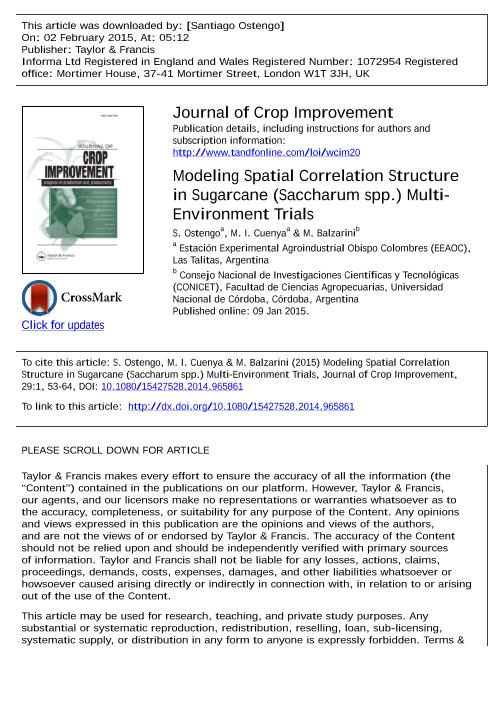Mostrar el registro sencillo del ítem
dc.contributor.author
Ostengo, Santiago

dc.contributor.author
Cuenya, María Inés

dc.contributor.author
Balzarini, Monica Graciela

dc.date.available
2018-05-11T14:26:31Z
dc.date.issued
2015-01
dc.identifier.citation
Ostengo, Santiago; Cuenya, María Inés; Balzarini, Monica Graciela; Modeling Spatial Correlation Structure in Sugarcane (Saccharum spp.) Multienvironment Trials; Taylor & Francis, Inc.; Journal of Crop Improvement; 29; 1; 1-2015; 53-64
dc.identifier.issn
1542-7536
dc.identifier.uri
http://hdl.handle.net/11336/44887
dc.description.abstract
Comparative multienvironment trials (METs) of sugarcane genotypes are frequently conducted using a randomized complete-block design (RCBD) within environments. However, blocking does not always ensure spatial variation control because of differential competition for resources among neighboring genotypes. Heterogeneity within trials may also cause between-trial heterocedasticity. This work aims to evaluate different Linear Mixed Models (LMMs) that enable the analysis of spatial correlation and residual heterogeneity among trials for both tons of cane per hectare (TCH) and sucrose content (SC%) in three series of mutienvironmetal trials conducted to evaluate advanced sugarcane clones. A total of 16 sugarcane trials conducted at different sites and in different crop cycles (age) were analyzed. Individual (age×site combination) and multienvironment analyses were performed. For SC%, the classic RCBD analysis within trial was adequate. For TCH, the anisotropic autoregressive model of order 1 (AR1×AR1) was the best to compare genotype means in most trials, allowing gain in information equivalent, on average, to the addition of 1.6 replicates to the original design. In the case of multienvironment analysis, the AR1×AR1 within-trial with among-trial heteroscedasticity was the best model to compare variety means, both for TCH and SC%. The results showed how a more appropriate mixed model would help avoid commission of judgment errors in sugarcane variety recommendations.
dc.format
application/pdf
dc.language.iso
eng
dc.publisher
Taylor & Francis, Inc.
dc.rights
info:eu-repo/semantics/openAccess
dc.rights.uri
https://creativecommons.org/licenses/by-nc-sa/2.5/ar/
dc.subject
Anisotropic-Autoregressive Spatial Models
dc.subject
Efficiency
dc.subject
Experimental Design
dc.subject
Linear Mixed Model
dc.subject
Yield Trials
dc.subject.classification
Otras Biotecnología Agropecuaria

dc.subject.classification
Biotecnología Agropecuaria

dc.subject.classification
CIENCIAS AGRÍCOLAS

dc.title
Modeling Spatial Correlation Structure in Sugarcane (Saccharum spp.) Multienvironment Trials
dc.type
info:eu-repo/semantics/article
dc.type
info:ar-repo/semantics/artículo
dc.type
info:eu-repo/semantics/publishedVersion
dc.date.updated
2018-05-09T14:08:10Z
dc.journal.volume
29
dc.journal.number
1
dc.journal.pagination
53-64
dc.journal.pais
Estados Unidos

dc.description.fil
Fil: Ostengo, Santiago. Gobierno de Tucumán. Ministerio de Desarrollo Productivo. Estación Experimental Agroindustrial Obispo Colombres; Argentina
dc.description.fil
Fil: Cuenya, María Inés. Gobierno de Tucumán. Ministerio de Desarrollo Productivo. Estación Experimental Agroindustrial Obispo Colombres; Argentina
dc.description.fil
Fil: Balzarini, Monica Graciela. Consejo Nacional de Investigaciones Científicas y Técnicas; Argentina. Universidad Nacional de Córdoba. Facultad de Ciencias Agropecuarias; Argentina
dc.journal.title
Journal of Crop Improvement
dc.relation.alternativeid
info:eu-repo/semantics/altIdentifier/doi/https://dx.doi.org/10.1080/15427528.2014.965861
dc.relation.alternativeid
info:eu-repo/semantics/altIdentifier/url/https://www.tandfonline.com/doi/abs/10.1080/15427528.2014.965861
Archivos asociados
